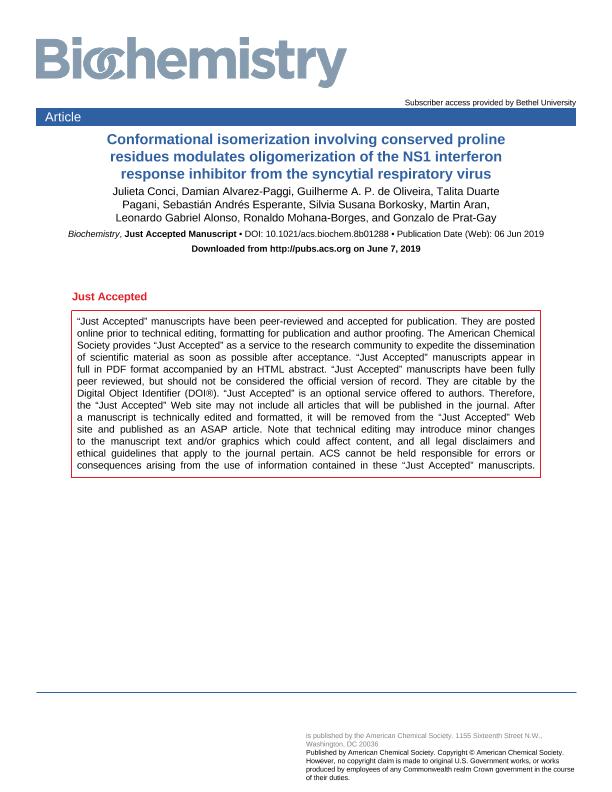Artículo
Conformational Isomerization Involving Conserved Proline Residues Modulates Oligomerization of the NS1 Interferon Response Inhibitor from the Syncytial Respiratory Virus
Conci, Julieta ; Álvarez Paggi, Damián Jorge
; Álvarez Paggi, Damián Jorge ; de Oliveira, Guilherme A. P.; Pagani, Talita Duarte; Esperante, Sebastian
; de Oliveira, Guilherme A. P.; Pagani, Talita Duarte; Esperante, Sebastian ; Borkosky, Silvina Susana; Aran, Martin
; Borkosky, Silvina Susana; Aran, Martin ; Alonso, Leonardo Gabriel
; Alonso, Leonardo Gabriel ; Mohana Borges, Ronaldo; de Prat Gay, Gonzalo
; Mohana Borges, Ronaldo; de Prat Gay, Gonzalo
 ; Álvarez Paggi, Damián Jorge
; Álvarez Paggi, Damián Jorge ; de Oliveira, Guilherme A. P.; Pagani, Talita Duarte; Esperante, Sebastian
; de Oliveira, Guilherme A. P.; Pagani, Talita Duarte; Esperante, Sebastian ; Borkosky, Silvina Susana; Aran, Martin
; Borkosky, Silvina Susana; Aran, Martin ; Alonso, Leonardo Gabriel
; Alonso, Leonardo Gabriel ; Mohana Borges, Ronaldo; de Prat Gay, Gonzalo
; Mohana Borges, Ronaldo; de Prat Gay, Gonzalo
Fecha de publicación:
07/2019
Editorial:
American Chemical Society
Revista:
Biochemistry
ISSN:
0006-2960
Idioma:
Inglés
Tipo de recurso:
Artículo publicado
Clasificación temática:
Resumen
Interferon response suppression by the respiratory syncytial virus relies on two unique nonstructural proteins, NS1 and NS2, that interact with cellular partners through high-order complexes. We hypothesized that two conserved proline residues, P81 and P67, participate in the conformational change leading to oligomerization. We found that the molecular dynamics of NS1 show a highly mobile C-terminal helix, which becomes rigid upon in silico replacement of P81. A soluble oligomerization pathway into regular spherical structures at low ionic strengths competes with an aggregation pathway at high ionic strengths with an increase in temperature. P81A requires higher temperatures to oligomerize and has a small positive effect on aggregation, while P67A is largely prone to aggregation. Chemical denaturation shows a first transition, involving a high fluorescence and ellipticity change corresponding to both a conformational change and substantial effects on the environment of its single tryptophan, that is strongly destabilized by P67A but stabilized by P81A. The subsequent global cooperative unfolding corresponding to the main β-sheet core is not affected by the proline mutations. Thus, a clear link exists between the effect of P81 and P67 on the stability of the first transition and oligomerization/aggregation. Interestingly, both P67 and P81 are located far away in space and sequence from the C-terminal helix, indicating a marked global structural dynamics. This provides a mechanism for modulating the oligomerization of NS1 by unfolding of a weak helix that exposes hydrophobic surfaces, linked to the participation of NS1 in multiprotein complexes.
Palabras clave:
interferon response
,
folding
,
oligomerization
,
syncytial virus
Archivos asociados
Licencia
Identificadores
Colecciones
Articulos(IIBBA)
Articulos de INST.DE INVEST.BIOQUIMICAS DE BS.AS(I)
Articulos de INST.DE INVEST.BIOQUIMICAS DE BS.AS(I)
Articulos(SEDE CENTRAL)
Articulos de SEDE CENTRAL
Articulos de SEDE CENTRAL
Citación
Conci, Julieta; Álvarez Paggi, Damián Jorge; de Oliveira, Guilherme A. P.; Pagani, Talita Duarte; Esperante, Sebastian; et al.; Conformational Isomerization Involving Conserved Proline Residues Modulates Oligomerization of the NS1 Interferon Response Inhibitor from the Syncytial Respiratory Virus; American Chemical Society; Biochemistry; 58; 26; 7-2019; 2883-2892
Compartir
Altmétricas



